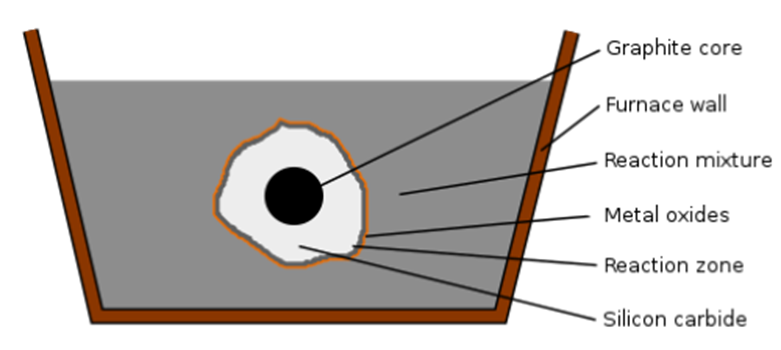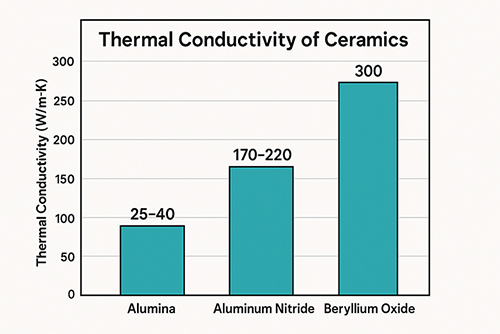Methods to Produce Silicon Carbide and Their Advantages
Introduction
Silicon carbide, SiC or carborundum, is a performance compound made up of silicon and carbon. It has excellent properties, including great hardness, high thermal conductivity, exceptional thermal heat shock resistance, and impressive resistance to wear and corrosion.
Because of these properties, silicon carbide ceramics have been mass-produced and used in many fields. It is applied to the metallurgy, automotive, semiconductor, and electronic industries. Additionally, you can find this tough ceramic extensively used to make abrasives.
SiC can be produced using several methods, each with its advantages and disadvantages. In this article, we will discuss these methods in detail. Hope that you can have a better comprehension of the features, synthesis, and applications of SiC.
Methods to Produce Silicon Carbide and Their Advantages
--Acheson Process
The Acheson process is the most widely utilized method to prepare SiC. This process was invented by Edward Goodrich Acheson to make SiC and graphite in 1893, and numerous silicon carbide plants employ the same design ever since. The procedures are listed below.
- Feedstock: The feedstock consists of SiO2 in the form of silica or quartz sand and carbon in the form of powdered coke.
- Mixing: The first step is to mix silicon dioxide and carbon in an electric resistance furnace. A graphite rod stands in the center, while other substances surround the core (see Figure 1).
- Heating: Then, a current is passed through the graphite rods to heat it to high temperatures of about 2200°C.
- Finally, a layer of silicon carbide is formed around the rod, and CO emits.
The manufacturing process is advantageous because it can produce SiC with large crystal sizes. In addition, the process is relatively simple and cost-effective.
 [1]
[1]
Figure 1. Acheson Process
Related reading: An Overview of Silicon Carbide Ceramic Materials
--Reaction Bonded SiC (RBSC)
Reaction-bonded SiC is another approach. RBSC uses a mixture of silicon carbide and carbon. The process involves the following steps.
- Mixing: combine coarse silicon carbide, silicon, and plasticizers together.
- Machining: form the blending into a desirable shape.
- Heating: expose these pieces to liquid or vapor silicon at high temperatures, and set them for further polishing.
You can get cost-effective and easily machineable silicon carbide ceramics after these steps. Reaction-bonded SiC is beneficial since it can make high-strength SiC, and the process can be used to produce complex shapes.
Related reading: Main Production Methods of Silicon Carbide Ceramics
--Modified Lely Process
Based on the Acheson process, the Lely method synthesizes bulk silicon carbide crystals through sublimation. The process can be divided into mixing and heating as well.
- Mixing: Powdered silicon and carbon are placed in a graphite crucible.
- Heating: The crucible is heated to high temperatures of about 2000°C in a vacuum or inert gas environment.
SiC sublimes and is deposited on the graphite rod at the center of the crucible. The modified Lely process provides SiC single crystals with high purity and high crystalline quality.
--Chemical Vapor Deposition (CVD)
CVD is a method of producing SiC using a gas-phase reaction. The steps are listed below.
- Feedstock: introduce SiC precursors, such as silicon tetrachloride (SiCl4), into a high-temperature reactor.
- Reaction: React the precursors with a carbon-containing gas, such as methane (CH4), to form SiC.
The CVD process is beneficial because it can produce SiC with high purity and uniform composition. Besides, the process can be used to deposit SiC onto substrates, making it useful for producing related coatings.
Related Reading: What is Chemical Vapor Deposition (CVD)?
 [2]
[2]
Figure 2. Schematic Diagram of a Chemical Vapor Deposition System
Comparison Table
Thereafter, silicon carbide is classified and further processed for diverse applications. A broad range of SiC products are carefully crushed, milled, machined, and chemically treated for specific enhanced properties. You can check the table below for more information.
Table 1. Methods to Produce Silicon Carbide and Their Advantages
|
Methods |
Benefits |
|
Acheson Process |
Most widely used; Large crystal size; Simple and cost-effective; |
|
Reaction Bonded SiC (RBSC) |
Common method; High strength; Complex shapes; |
|
Modified Lely Process |
Making single crystals; High purity; High crystal quality; |
|
Chemical Vapor Deposition (CVD) |
Making coatings; High Purity; Uniform composition; |
Conclusion
In a word, SiC is a valuable material with excellent properties, and the production methods discussed in this article offer unique advantages. The Acheson process is the most widely used method; reaction-bonded SiC comes with high strength and complex shapes; the modified Lely process offers high-purity single crystals; chemical vapor deposition offers high-purity coatings. The choice of production method depends on the specific application and desired properties.
Advanced Ceramic Materials (ACM) is a leading supplier of quality silicon carbide products with different synthesis methods. Send us an inquiry if you are interested.
Reference:
[1] Adham, Kamal & Bowes, G.. (2018). Natural Graphite Purification Through Chlorination in Fluidized Bed Reactor: Proceedings of the First Global Conference on Extractive Metallurgy. 10.1007/978-3-319-95022-8_211.
[2] Bącela J, Łabowska MB, Detyna J, Zięty A, Michalak I. Functional Coatings for Orthodontic Archwires—A Review. Materials. 2020; 13(15):3257. https://doi.org/10.3390/ma13153257
{{item.content}}
LEVE A REPLY
{{item.children[0].content}}
{{item.content}}
LEAVE A REPLY
SUBSCRIBE OUR NEWSLETTER
- Boron Nitride in Cosmetics: Enhancing Performance and Sensory Appeal
- Maximize MOCVD Yield and Purity with Hexagonal Boron Nitride Setters
- What Are the Advantages and Uses of Boron Nitride Ceramic Sheet?
- The Compression Annealing Advantage for Pyrolytic Boron Nitride
- Beyond Insulation: The Surprising Spectrum of Ceramic Thermal Conductivity











